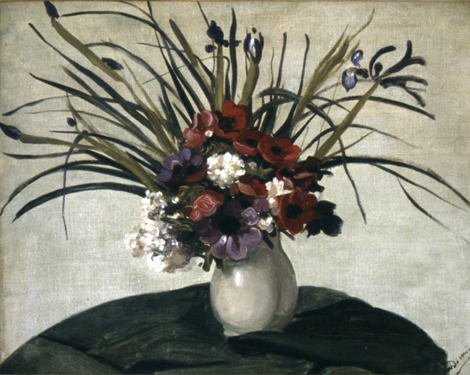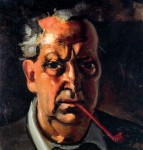
Andrè Derain
French, 1880-1954
Vase of Anemones, n.d.
oil on canvas
24 3/4 x 30 3/4 in.
SBMA, Gift of Mary and Leigh Block
1987.58.9

Derain self-portrait from 1953, a year before his death, painted in the subdued color palette that he preferred in his later years.
“We were always intoxicated with color, with words that speak of color, and with the sun that makes colors live”
Andre Derain
RESEARCH PAPER
Andre Derain was a French painter, sculptor, illustrator, stage designer and an avid collector of various forms of art. In a career spanning almost six decades he strove to learn, expand, evolve and perfect his art and technique. This drive led him to be instrumental in the development of numerous art movements and an innovator until his death in 1954.
Born on June 17,1880, Andre Derain first started painting landscapes at the age of 15 under the guidance of his friend La Noe. In 1898 he moved to Paris to study painting full time and was introduced to Maurice de Vlaminck and Henri Matisse. All three artists shared a common admiration for the work of Paul Cezanne and Vincent van Gogh. Vlaminck and Derain rented a studio together and the three became painting companions and close friends.
In 1901 military service interrupted Derain’s studies. During his time in the service he had little time to paint but spent his spare time studying poetry and the works of Friedrich Nietzsche and other German philosophers of the age. Upon his return to Paris in 1904 Derain was accepted to study painting at the “Academie Julien”. Derain’s friendship with Matisse and Vlaminck recommenced. In 1905 the three painters were exposed to a retrospective exhibit of Vincent van Gogh and the brush stokes and composition found in the work of Van Gogh had a profound impact on the group. In September of that same year, largely because of the encouragement of Matisse, the three decided to exhibit their painting at the “Salon d’ Automne”. The public found the works laughable. The intensely bright colors and the untraditional and unrealistic shapes, forms and subject matter were thought shocking. In a review on the exhibit the critic Louis Vauxcelles refered to the group and their work as “fauves”, or wild beasts, and the avant-garde “Fauvism” movement was born.
The exhibition and the ensuing debate had sparked the public’s interest in “The Fauvists” created a great demand for their work. Derain sold the entire contents of his studio to an art dealer bringing him newfound financial success. This money allowed him to travel to London twice over the next two years to paint, continuing his work painting with the planes of bold colors of the“ Fauvists” movement. These paintings of London and the Thames River continue to be some of his most popular works.
Upon his return to France, Derain befriended many of the up and coming popular writers, painters, and poets of the day such as Apollinaire and Georges Braque. In 1906 he moved to Montmartre where he and Braque became close friends with Pablo Picasso. All three shared a common passion for Cezanne and African Art, of which Derain was an avid collector. In 1907 Picasso introduced Derain to the intensely beautiful Alice Princet who soon became his wife. Derain’s art continued to evolve, soon into large-scale compositions and still-lives and in 1912 started what would later be named his “periode gothique”.
Yet again Derain was called into military service and served from 1914 until 1918 on the front lines in France during WW1. Not able to paint Derain still found time to illustrate Andre Breton’s Mont-de-Piete, a book that would not be published until several years after the war.
Returning from the war, Derain’s focus quickly turned from the cubist influence of Picasso and African Art. After a trip to Venice he became more and more entranced with 17th century Venetian painting. Moving constantly to paint, accompanied by his wife, he turned to the study of classic art works and dance. In the 1920’s he finished several large-scale paintings of harlequins and dancers, which had been popular themes in 17th and 18th Century Venice with the commedia del arte. Derain continued to do book illustrations, lithographs, painting and sculpture but in addition he began to design costumes and decorations for various Paris ballets.
From 1928 to 1932 Derain finished several floral paintings that were done in a similar style to “Vase of Anemones”. And although we don’t have a date on our painting there is a probability that our painting was done around this time period.
In the 1930’s Derain moved to yet another studio in Paris, were he became more drawn to religious studies and classical mythology. Here Andre produced numerous large pieces including nudes, still-life’s, mythological scenes in addition to several monumental paintings that would be the last of this scale in his career.
1935 brought yet another move to a new home and studio in Chambourcy. While landscaping in his yard he discovered a pit of white clay. Andre began to make the numerous small clay sculptures that would not be found until after his death. War was declared and Derain turned his focus from painting and produced a series of 400 color woodcuts that would be the highlight of his work during the WW2 era.
After the war, he completed numerous book illustrations and set and costumes designs. Later in his life he began to experiment with metal sculpture in addition to masks made from shells and shrapnel from WW1. Andre Derain worked constantly until his death in a car accident on June 8th of 1954 at the age of 74.
Our oil on canvas painting by Andre Derain is entitled “Vase of Anemones” it remains undated and was donated to the SBMA by Mary and Leigh Block. The painting is done in a very subtle and subdued palette. A simple grey/green vase of flowers on a table that is covered in an equally simple blue/green clothe. The perspective of the table gently tips it toward the viewer. Our eye is immediately drawn to the impasto carmine and purple anemones which are set off by the cream hydrangeas. The thickness of the paint and the swirl of the brush strokes give a great deal of texture and depth the flowers themselves. The background of yellow green is so thin and muted that the texture of the rough canvas shows through and almost takes on a wallpaper like quality. The warmth of the color brings the background toward the eye. The long spikes of blue Iris are done in an equally light brushstroke in the colors of both the background and the tablecloth. The iris flowers themselves take on a secondary significance to the intensely strong lines of the stems. Reaching in all directions they create a dynamic and geometric fan shape that dominates the painting. This fan shape is echoed subtly in the contours of the table. The deep blue/green of the tablecloth is folded back on itself in the lower left corner to give us a peak of the artist’s signature beneath.
Andre Derain’s evolution from his youthful work in Fauvism, through Cubism to his later more classical works made him the target of debate and criticism. His need to explore and evolve his art might and the motives behind that drive might never be understood. Simply that fact that there is so much controversy assures us that his work remains to be of great value to the world of art.
Prepared for the Santa Barbara Museum of Art Docent Council by Denise Klassen, April 2013.
Bibliography
Derain, Andre. Volume 19, The Dictionary of Art, Edition 1998
Lee, Jane. Derain, 1990
MOMA Website. Oxford Press
Lucie Smith, Edward. Lives of the Great 20th Century Artists.
Oxford University Press Website 2009
Heilbrunn Timeline of Art History. The Metropolitan Museum of Art Publication 2000
www.tate.org.uk
Derain, Andre. Wikipedia
Matisse, Henri Wikipedia
Fauvism, Wikipedia
The Wild Men of Paris: Matisse, Picasso and Les Fauves. The Architectural Record
Derain, Andre. The Art Directory Online
Derain, Andre. The Archive online
Fauves, http://www.humanitiesweb.org
